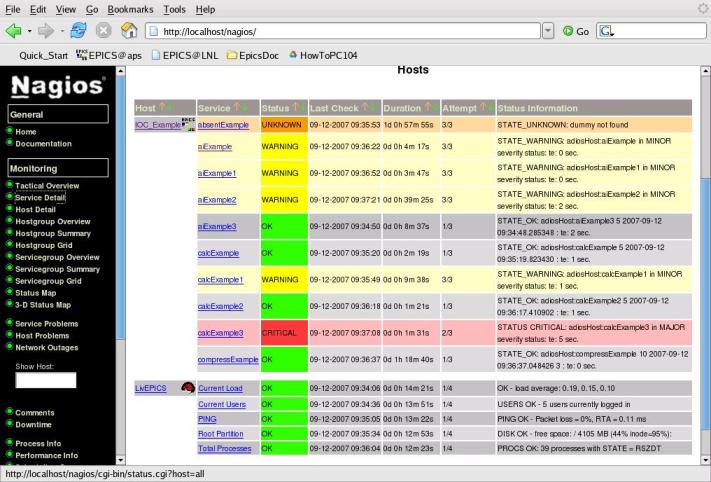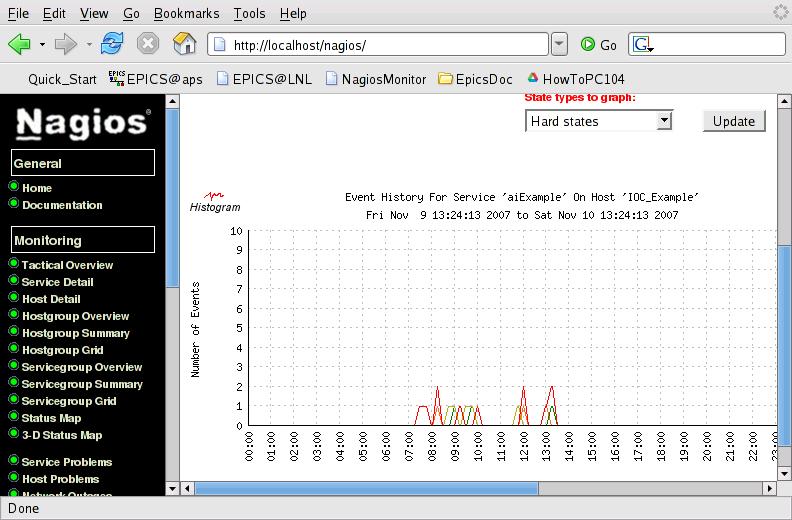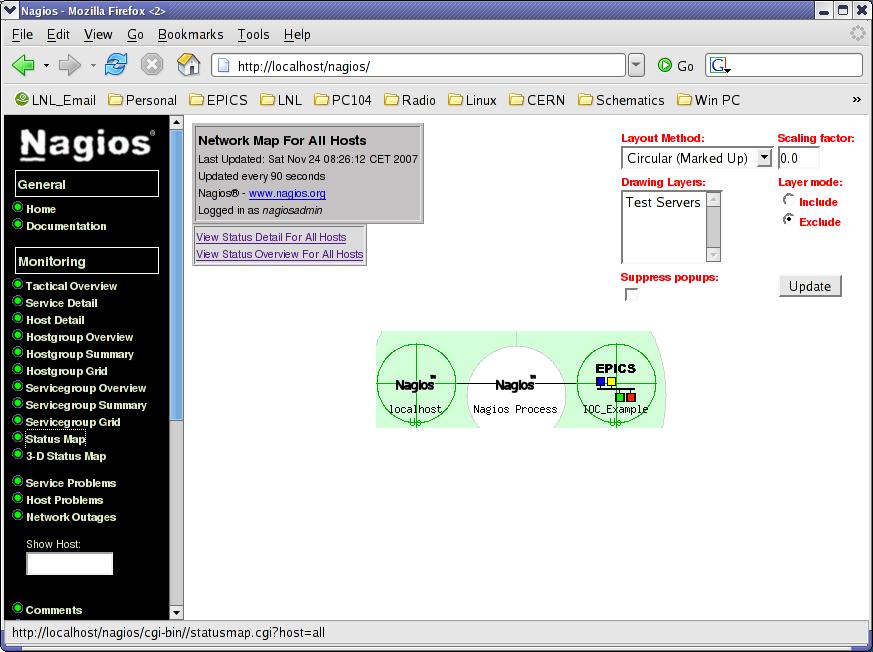From EPICSWIKI
Contents
Here’s how to install NAL using yum on RedHat Enterprise 5 x86 Linux box
Nagios default installation
Nagios application is provided by rpmforge repository, so you have to install it to configure yum properly.
See https://www.tecmint.com/enable-rpmforge-repository/ for instruction on how to achieve this.
After that, it is possible to install the Nagios application. For the “server side”, you need these following packages: 1) nagios: the main application package 2) nagios-plugins: provides all the command scripts used by users to define nagios services. In some cases there is also nagios-plugins-all (that’s better) 3) nagios-plugins-nrpe: provides the check_nrpe script used to communicate with nagios clients and run remote services
root> yum install -y nagios
root> yum install -y nagios-plugins
root> yum install -y nagios-plugins-nrpe
With that I’ve installed Nagios 3.2.3 version.
Nagios: configuration
When you install Nagios by yum, all the apache configuration are done by default.
To check the web interface you must define the password for nagiosadmin user (default nagios administrator). This passsword must be encrypted. you can use htpasswd command to set that an save in
/etc/nagios/htpasswd.users
Start the apache and nagios services
root> service httpd start (restart)
root> service nagios start
and check the nagios webpage at http://localhost.localdomain/nagios . If it is all correct, you have to see the authentication popup. When you are in the main page, you can monitor the localhost machine (nagios provides some information about hosts and services); all the services should be OK, but in some case you have to check some permissions/configurations.
The main configuration file is /etc/nagios/nagios.cfg
in this file you can configure every feature of nagios. We use most of the default options, the only parameters enabled are:
- enable servers directory: you can define all the servers’ cfg files into this directory (cleaner job)
cfg_dir=/etc/nagios/servers
and create the folder:
# mkdir /etc/nagios/servers
In the servers folder you have to define all the hosts you want to monitor. For a correct management, you have to define 2 different files:
- HOST.cfg: define the specifics that nagios uses to monitor the host desired. You must define one file per host!
- groups.cfg: indicate all the different groups of hosts. It is very useful to manage and monitor a large number of machines
Example:
- File servers/example.cfg:
define host{
use linux-server
host_name example
alias example display in web interface
address 10.6.0.1
notification_period 24x7
icon_image example.jpg
}
define service{
use local-service
host_name example
service_description PING
check_command check_ping!100.0,20%!500.0,60%
}
define service{
use local-service
host_name example
service_description SSH
check_command check_ssh
}
in this code: 1) notification_period is defined in /etc/nagios/objects/timeperiods.cfg –> you can edit this file to add/set different time periods 2) icon_image is situated in /usr/share/nagios/images/logos/. if you want to add new images you must save them in this place 3) service_description is the service name displayed in the web interface 4) check_command define the command desired and situated in /usr/lib/nagios/plugins
- File servers/groups.cfg:
define hostgroup{
hostgroup_name example ; The name of the hostgroup
alias example @ MyLab ; Long name of the group
members localhost, example
}
You have to define the host_name used before in members variable.
After these changes, verify the configuration files through
# nagios -v /etc/nagios/nagios.cfg
and then, if there aren’t any error, restart the service
# service nagios restart
Nagios Default Folder Locations
By default Nagios yum installation, Nagios stores the following file location into your harddisk
* /etc/nagios/ - Nagios configuration folder locations * /var/log/nagios/nagios.log - Nagios log * /usr/share/nagios/ - Nagios, docs, sounds, and image folder locations * /usr/lib/nagios/cgi/ - Nagios CGI folder location * /usr/bin - Nagios binaries * /etc/httpd/conf.d/nagios.conf - Nagios Apache folder files
Insert the EPICS Nagios Plugins
What you did in the chapters above was a generic Nagios installation/setup.
Going to here, You will find the nagios plugin to EPICS. Download the plugin and save into the
/usr/lib/nagios/plugins/
Change the permission to check_caget.sh
root> chmod +x check_caget.sh
now verify that is usable with:
> ./check_caget.sh --help
verfing using camonitor a PV, i.e. for me giacchinHost:aiExample
> camonitor giacchinHost:aiExample
Note: After the version 1.3 the plugin assume the presence of caget in /usr/bin If that is not true at your site, please fix it making a symbolic link like (i.e.): ln -s /opt/epics/base-3.14.9/bin/linux-x86/caget /usr/bin/caget
Using the EPICS environment variables you should avoid to broadcast to the network, for me the applicable values were:
EPICS_CA_AUTO_ADDR_LIST=NO
EPICS_CA_ADDR_LIST=127.0.0.1
therefore may I test the plugin with the follow command:
> ./check_caget_dev_gw.sh -pv giacchinHost:aiExample -H 127.0.0.1
> STATE_OK: giacchinHost:aiExample 5 2007-11-16 15:23:18.560231 ; te: 0 sec.
if that reply correctly the status of your PV you can continue the installation.
Now install the EPICS logos images
Download the epics.gif image available from the same place
and install that:
root> mv epics,gif /usr/share/nagios/images/logos/
Save the original Nagios setup and replace it
Go to /etc folder and save the original setup
root> tar cvf nagios.or.tar ./nagios/
download there the etc.nagios.tar available at same place
and restore the nagios folder with that:
root> tar xvf ./etc.nagios.tar
Note: Now looking around the files into /etc/nagios and adjust that to meet your network setup requirements. You will find an epicsExample.cfg which contains a pre-setted PV names, please adjust that to meet the yours.
NAGIOS check configuration file
For sanity checking, make sure you verify Nagios config files. This can be done like so
root> nagios -v /etc/nagios/nagios.cfg
The above command would show you for any erroneous lines frin Nagios config file.
HTTPD configuration
Check the presence of line: “include conf.d/*.conf”
in /etc/httpd/conf/httpd.conf
Check the paths into the file : /etc/httpd/conf.d/nagios.conf
Make a file named .htaccess into /usr/lib/nagios/cgi-bin/ and /usr/share/nagios/html/
which will contains:
AuthName "Nagios Access" AuthType Basic AuthUserFile /etc/nagios/passwd require valid-user
Now create a nagios user with the following command:
root> htpasswd -c /etc/nagios/passwd nagiosadmin
SELinux setup
For the first test: set it permissive by
root> system-config-securitylevel
NAGIOS as a Linux service
Basically, at this point of basic Nagios configuration, restarting Nagios should be successful.
Reload your apache service together with your Nagios service like so
root> service httpd restart
root> service Nagios stop
root> service Nagios start
root> service Nagios status
Open your favorite web-browser on http://localhost/nagios/
login like “nagiosadmin”, give your password and enjoy!
NB. If you are using my etc.nagios.tar the passwd to login is “nagiosadmin”
See my nagios screen shots in action:
Nagios Service Details

Nagios Alert Histogram

Nagios Status Map

Conclusions
There are a lot of other interesting feature that comes from free using NAGIOS, looking around you should find a lot yourself. There is a cool Firefox plugin https://exchange.nagios.org/directory/Addons/Frontends-%28GUIs-and-CLIs%29/Web-Interfaces/nagioschecker–2D-Firefox-Addon/details which give you the possibility to continuous monitoring the PVs during the regular usage of the browser.
At this time Ralph Lange has realized a test to NAL at Bessy. A great acknowledgments to him, he has supported me since the idea of use Nagios born in my mind. Acknowledgments to Maurizio Montis, who made a kickstart script to deploy a RHEL5 box equipped with Nagios ready to use, and, adjust and fix the old notes on FC7 to the new OS: RHEL5.
More information about NAL could be found here. A special LivEPICS version (Linux Live CD EPICS fully equipped) with NAGIOS pre-setted and ready to use here .
Thank you for your attention! Please, give me a your feedback, and fell free to drop me an email, I’ll be happy to continue to work on this idea if someone is interested to use it.
—MauroGiacchini 15.54, 2 Dec 2011
The Plugin Script
/usr/lib/nagios/plugins/check_caget_dev_gw.sh script for Nagios
#!/bin/sh
#
#####################################################################################
#####################################################################################
## Nagios plugin to check EPICS PV Status ##
#####################################################################################
#####################################################################################
#
# Script to retrieve EPICS PV Name status using the "caget" command.
# Written by Mauro Giacchini (mauro.giacchini@lnl.infn.it)
# Last Modified: 17-11-2007
#
# Usage: ./check_caget.sh -pv <PV name>
#
# Description:
# This script uses caget command to retrieve the PV status.
#
# Limitations:
# This script has been tested on Linux Fedora Core 6.
#
# Output:
# The output contains the "te" time elapsed calculated like a difference from PV's
# timestamp and the linux "date" command (suggestion: use ntp common server
# to IOCs and Nagios server box). The STATUS of the service (..of the PV)
# follow the severity rules:
#
# Severity (none) >>>> STATE_OK # OK = green
#
# Severity MINOR >>>> STATE_WARNING # WARNING = yellow
#
# Severity MAJOR >>>> STATE_CRITICAL # CRITICAL = red
#
# PV not found >>>> STATE_UNKNOWN # UNKNOWNN = orange
#
# In case of Severity (none) it show the stdout of "caget -a" with appended the "te".
#
# Other notes:
# Firefox Plugin : A FireFox extension is avilable to monitor Nagios server.
# https://exchange.nagios.org/directory/Addons/Frontends-%28GUIs-and-CLIs%29/Web-Interfaces/nagioschecker--2D-Firefox-Addon/details
#
# Nagios configuration setup:
# You need to add the command to commands.cfg
#
# define command{
# command_name check_caget
# command_line $USER1$/check_caget.sh -pv $ARG1$
# }
#
# And, you need to add the service to services.cfg
#
# define service{
# use generic-service ;
# host_name IOC_Example ;
# service_description aiExample ;
# is_volatile 0 ;
# check_period 24x7 ;
# max_check_attempts 3 ;
# normal_check_interval 3 ;
# retry_check_interval 1 ;
# contact_groups admins ;
# notification_interval 120 ;
# notification_period 24x7 ;
# notification_options w,u,c,r ;
# check_command check_caget!rootHost:aiExample ;
# }
#
# then place this script in the /usr/lib/nagios/plugins/ on the Nagios box server.
# Don't forget to set the right execution permission to this file.
#
# Threshold and ranges: please, have a look at:
# http://nagios-plugins.org/doc/guidelines.html#THRESHOLDFORMAT
#
# Last: This script still needs debugging and fixups (exercise for reader) :-)
#
#####################################################################################
# DEBUGGING OPTION
# This option determines whether or not debugging messages are showed
# Values: 0=debugging off, 1=debugging on
DEBUG="0"
#####################################################################################
# CAGET LOCATION
# This option determines where the caget executable is located.
# The default /usr/bin/caget should be made with a symbolic link
# made by root (i.e.): ln -s /opt/epics/base-3.14.9/bin/linux-x86/caget /usr/bin/caget
CAGET_LOCATION=/usr/bin/caget
#####################################################################################
# Script exit status
STATE_OK=0 # OK = green
STATE_WARNING=1 # WARNING = yellow
STATE_CRITICAL=2 # CRITICAL = red
STATE_UNKNOWN=3 # UNKNOWNN = orange
VERSION="v1.3"
#####################################################################################
# print_revision() function
print_revision (){
echo "Check_caget (nagios-plugins 1.4 to nagios 2.9) (EPICS base 3.14.9) $VERSION"
}
#####################################################################################
# print_usage() function
print_usage() {
echo ""
echo "Usage: check_caget_dev_gw -pv <PV name> "
echo "Usage: check_caget_dev_gw -pv <PV name> -H <EPICS_CA_ADDR_LIST>"
echo "Usage: check_caget_dev_gw -pv <PV name> -p <EPICS_CA_SERVER_PORT>"
echo "Usage: check_caget_dev_gw -pv <PV name> -expval <EXPECTED VALUE>"
echo "Usage: check_caget_dev_gw [-h] [--help]"
echo "Usage: check_caget_dev_gw [-V]"
echo ""
}
#####################################################################################
# print_help() function
print_help() {
echo ""
print_usage
echo ""
echo "Script to retrieve the PV status for EPICS control systems."
echo ""
echo "This plugin not developped by the Nagios Plugin group."
echo "Please do not e-mail them for support on this plugin, since"
echo "they won't know what you're talking about :P"
echo ""
echo "For contact info: mauro.giacchini@lnl.infn.it"
echo "Download : https://web.infn.it/epics/index.php/resources"
echo ""
}
#####################################################################################
# Check the caget presence.
verify_caget_presence() {
if ! type $CAGET_LOCATION >/dev/null 2>&1; then
echo "STATUS CRITICAL: caget not found (Did you set up the rigth one Nagios USERn? _or_ caget not found!)"
exit $STATE_CRITICAL
fi
}
#####################################################################################
# Control caget plugin input parameters
EXPVAL=""
EPICS_CA_ADDR_LIST="" # Default YES
EPICS_CA_SERVER_PORT="" # Default 5064 _and_ value > 5000
EPICS_CA_SERVER_PORT_MIN="5000"
while test -n "$1"; do
case "$1" in
--help)
print_help
exit $STATE_OK
;;
-h)
print_help
exit $STATE_OK
;;
-V)
print_revision
exit $STATE_OK
;;
-pv)
PVNAME=$2
shift
;;
-expval)
EXPVAL=$2
if [ -z $EXPVAL ]; then
echo "STATUS CRITICAL: Expected value absent"
exit $STATE_CRITICAL
fi
shift
;;
-H)
EPICS_CA_ADDR_LIST=$2
if [ -z $EPICS_CA_ADDR_LIST ]; then
echo "STATUS CRITICAL: Expected EPICS_CA_ADDR_LIST absent"
exit $STATE_CRITICAL
fi
export EPICS_CA_ADDR_LIST
EPICS_CA_AUTO_ADDR_LIST="NO"
export EPICS_CA_AUTO_ADDR_LIST
shift
;;
-p)
EPICS_CA_SERVER_PORT=$2
if [ -z $EPICS_CA_SERVER_PORT ]; then
echo "STATUS CRITICAL: Expected EPICS_CA_SERVER_PORT absent"
exit $STATE_CRITICAL
fi
if [ $EPICS_CA_SERVER_PORT -le $EPICS_CA_SERVER_PORT_MIN ]; then
echo "STATUS CRITICAL: Expected EPICS_CA_SERVER_PORT minor than allowed (5001)"
exit $STATE_CRITICAL
fi
export EPICS_CA_SERVER_PORT
shift
;;
*)
echo ""
echo "Unknow argument: $1"
print_usage
exit $STATE_UNKNOWN
;;
esac
shift
done
verify_caget_presence
if [ -z $PVNAME ]; then
echo "STATUS CRITICAL: PV Name not specified"
exit $STATE_CRITICAL
fi
#####################################################################################
# FINALLY... RETRIEVING THE VALUES (caget)
#CAGET_REPLY=`caget -a $PVNAME`
CAGET_REPLY=`$CAGET_LOCATION -a $PVNAME`
IFS=" "
read pvname date time value status severity<<END
$CAGET_REPLY
END
if [ -z $pvname ]; then
echo "STATE_UNKNOWN: $PVNAME not found"
exit $STATE_UNKNOWN
fi
#####################################################################################
# Calculus difference between the PV timestamp and the actual time
SPACE=" "
dte1=$(date --date "$date$SPACE$time" +%s)
dte2=$(date +%s)
diffSec=$((dte2-dte1))
if ((diffSec < 0)); then abs=-1; else abs=1; fi
te=$((diffSec/abs))
# echo "Time elapsed (sec.): $te"
#####################################################################################
# Output the NAGIOS status using an expected value
if [ $EXPVAL ]; then
if [[ $value -eq $EXPVAL ]] ;
then echo "STATE_OK: Expected value ($EXPVAL) to $pvname match; te: $te sec."
exit $STATE_OK;
else echo "STATUS CRITICAL: Expected value ($EXPVAL) to $pvname didn't match"
exit $STATE_CRITICAL;
fi
fi
#####################################################################################
# Output the NAGIOS status using the Severity field
case $severity in
MAJOR)
echo "STATUS CRITICAL: $pvname in MAJOR severity status; te: $te sec."
exit $STATE_CRITICAL
;;
MINOR)
echo "STATE_WARNING: $pvname in MINOR severity status; te: $te sec."
exit $STATE_WARNING
;;
*)
echo "STATE_OK: $pvname $value $date $time $status ; te: $te sec."
exit $STATE_OK
;;
esac